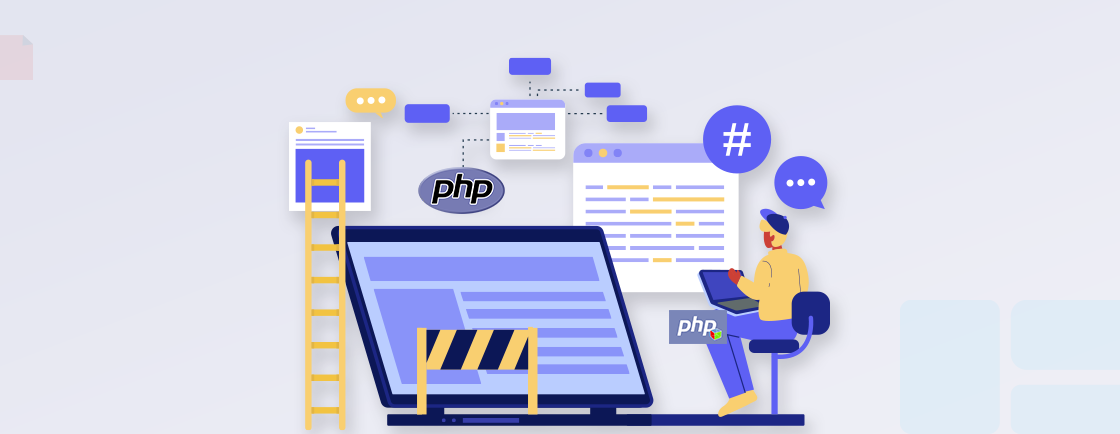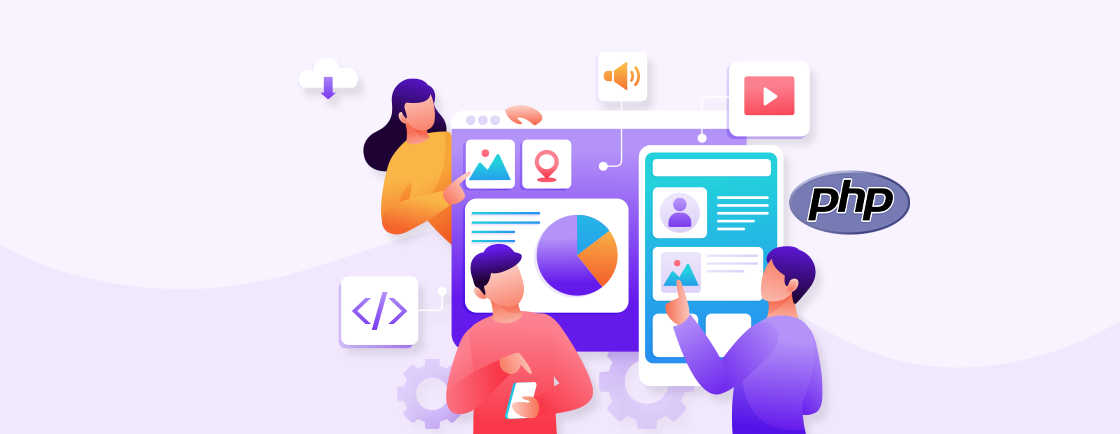Table of Contents
Ever wished you could build a desktop app using just PHP? Yeah, you heard it right. No need to learn Java, C++, or anything else.
NativePHP makes this possible. It bridges the gap between the web and the desktop, letting you use your PHP skills to create native desktop applications.
In this blog, we’ll walk you through the basics of NativePHP, its setup, and how expert PHP developers use it. Let’s get started.
What is NativePHP?
NativePHP is a framework that lets you build desktop apps using PHP — the same language you use for building websites.
With NativePHP, you can create desktop features like windows, buttons, file upload dialogs, and even system notifications.
The best part? You don’t need to learn a new language like Java or C#. Just use your PHP skills and build apps that work on Windows, macOS, and Linux.
Key Highlights:
- Write desktop apps using PHP (and Laravel)
- Access native system features like file dialogs and notifications
- Create cross-platform applications from a single codebase
- Ideal for developers who already use PHP for web development
Whether it’s a simple internal tool or a full-fledged desktop app, NativePHP makes it possible with ease.
How Does NativePHP Work?
NativePHP works by combining your PHP backend with a native desktop shell, allowing you to create desktop apps using familiar web development tools.
It uses technologies like Tauri to wrap your application in a native window while you continue writing your logic in PHP and your UI in HTML/CSS/JS (or Blade if you’re using Laravel).
What It Uses:
- PHP or Laravel for backend logic
- HTML/CSS/JavaScript or Blade for frontend
- Tauri to create native desktop shells
- Node.js (lightly) to support frontend assets
This setup lets you build apps that look and feel native without leaving the PHP world.
Setting Up NativePHP
Getting started with NativePHP is easier than you might think, especially if you’re already familiar with Laravel or PHP. Below is a quick guide to help you set things up.
Prerequisites
Make sure you have the following tools installed:
- PHP (version 8.1 or higher)
- Composer (for managing PHP packages)
- Node.js & npm (used for frontend assets and Tauri)
- Laravel (optional but highly recommended)
Installation Steps
Follow these steps to create your first NativePHP app:
1. Create a new Laravel project
This code will create a new Laravel project:
composer create-project laravel/laravel nativeapp
It’s just like starting a regular web app, but this one’s going to run on your desktop.
2. Navigate into the project folder
Now you’re inside the project folder. All your app files will be saved here:
cd nativeapp
3. Install NativePHP package
This command pulls in the NativePHP package.
composer require nativephp/electron
It uses Electron in the background to bring your Laravel app to the desktop, so you don’t have to deal with Electron directly.
4. Start the desktop application
That’s it. Run this command, and your Laravel app will pop up as a desktop window:
php artisan native:serve
No browser or server is needed; it just works like a native app.
Project Structure
Once everything is set up, your project will still look and feel like a regular Laravel app.
You’ll still use all the usual tools like routes, controllers, Blade templates, Vite, etc.
But now, you can also add native features like desktop windows, menus, system alerts, and more.
Building a Simple Desktop App
Let’s build a basic To-Do List desktop app using Laravel and NativePHP. This example will help you understand how everything works together.
Step 1: Create a Route
Add a simple route in your web.php file:
Route::get('/', function () {
return view('todo');
});
Step 2: Create a Blade View
In resources/views/, create a file named todo.blade.php and add basic HTML:
<!DOCTYPE html>
<html>
<head>
<title>To-Do List</title>
</head>
<body>
<h1>My To-Do List</h1>
<form method="POST" action="/add-task">
@csrf
<input type="text" name="task" placeholder="Enter a task" required>
<button type="submit">Add</button>
</form>
</body>
</html>
Step 3: Handle Task Logic
Add another route to handle form submissions:
Route::post('/add-task', function (Illuminate\Http\Request $request) {
// Handle the task (e.g., save to file or session)
return redirect('/');
});
Step 4: Run the App
Start the desktop app using:
php artisan native:serve
A native window will open with your Laravel-powered to-do list.
Pro Tip:
You can enhance this app by:
- Saving tasks to a local database or file
- Using system notifications when a task is added
- Styling with CSS or Tailwind for a polished UI
With just a few lines of code, you’ve built a real desktop app using PHP!
If you want to build powerful native applications with PHP, hire PHP developers from our team today.
NativePHP vs Other Desktop Frameworks
There are many tools available for building desktop apps, but most require learning new languages or frameworks. Here’s how NativePHP compares with a few popular options:
Comparison Table
| Feature / Framework | NativePHP | Electron | Python + Tkinter |
|---|---|---|---|
| Language | PHP | JavaScript | Python |
| Cross-Platform | Yes | Yes | Yes |
| Learning Curve | Easy (for PHP devs) | Moderate | Moderate |
| UI Capabilities | Web-based UI | Web-based UI | Basic GUI |
| Community Support | Growing | Large | Established |
| Performance | Fast (via Tauri) | Heavy (uses Chromium) | Lightweight |
Key Takeaways:
- NativePHP is ideal for developers who already know PHP and want to build desktop apps without switching languages.
- Electron is powerful but can be resource-heavy due to its Chromium engine.
- Tkinter is simple but offers limited UI features compared to web-based interfaces.
If you’re a PHP developer, NativePHP gives you the easiest path to building real desktop apps using the tools and language you already know.
Where Can You Use NativePHP?
NativePHP opens up a world of possibilities for developers looking to create desktop applications using PHP. Here are some practical use cases for NativePHP:
Internal Business Tools
NativePHP is perfect for creating internal applications that are used within a company. You can build tools like:
- Employee management systems
- Inventory tracking apps
- Internal communication apps
These apps can run offline and provide employees with a seamless experience on their desktops.
File Converters or Data Processors
Build desktop utilities like file converters or batch processors:
- Convert documents, images, or audio files
- Process large sets of data locally
- Provide users with a fast and efficient offline tool
Offline Applications for Sales or Inventory
For businesses that need to manage sales, inventory, or client information offline, NativePHP is a great choice:
- POS (Point of Sale) systems
- Sales tracking apps
- Inventory management tools
These apps can sync data once online and run independently when offline.
Simple Editors (Notes, Tasks, Reports)
Create simple yet powerful desktop editors:
- To-do list apps
- Note-taking applications
- Report generation tools
These are useful for personal or team productivity.
Admin Dashboards for Local Data
If you work with local databases or APIs, you can build admin dashboards that work entirely offline:
- Display data in tables, charts, and graphs
- Manage customer records or analytics
- Interact with local files and data sources
Games or Interactive Apps
Though less common, you can even use NativePHP to create simple games or interactive apps with engaging user interfaces.
Why Choose NativePHP for These Applications?
- Offline Capability: Works without an internet connection, ideal for fieldwork or remote locations.
- Cross-Platform: Runs on Windows, macOS, and Linux, so you can target multiple platforms.
- PHP Power: Leverage your existing PHP knowledge to build desktop apps easily.
NativePHP makes it possible to take your PHP skills and create powerful desktop apps for a wide range of use cases, from internal tools to offline utilities. Whether you’re building simple apps or more complex software, NativePHP helps you bring your ideas to life without learning a new programming language.
Let’s Summarize
NativePHP lets you build desktop apps without learning a whole new language or toolset. You can stay in your Laravel comfort zone and still create apps that run on Windows, macOS, and Linux.
Whether you’re building an internal tool, a small editor, or even a lightweight game, NativePHP gives you the freedom to do it with just PHP.
It’s easy to set up, works like regular Laravel, and opens up a whole new world of possibilities. If you know Laravel, you already know half the job.
If you need advanced functionalities for your NativePHP application, partnering with our PHP development company will help you unlock its full potential and create seamless native experiences.
FAQs for NativePHP
What is native PHP used for?
NativePHP is used to build desktop applications using PHP. It’s great for creating tools like admin panels, file converters, offline apps, or simple editors — all without switching to another programming language.
Can NativePHP be used for mobile app development?
NativePHP is primarily designed to create desktop applications rather than mobile apps. While you can use web technologies like HTML, CSS, and JavaScript to build the user interface, mobile platforms such as iOS and Android typically require frameworks like React Native or Flutter.
Is NativePHP suitable for building high-performance desktop apps?
NativePHP works well for many desktop apps, especially those that focus on lightweight functionality or internal tools. However, if you’re aiming to build a resource-intensive application, such as complex video editing software or high-performance games, other frameworks like Electron or native development languages may provide better performance.
How do I handle updates for my NativePHP desktop app?
To manage updates for NativePHP desktop applications, you can integrate tools like Tauri or Electron-builder, which allow you to package your app with an auto-update feature. You can configure your app to check for updates from a server and automatically download and install them.
Master PHP Web Development
Access expert guides and tips to enhance your PHP programming capabilities.





